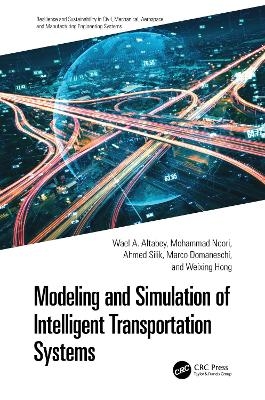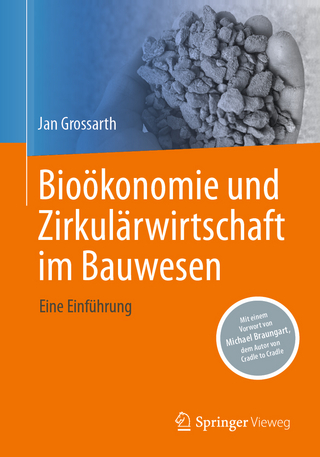
Modeling and Simulation of Intelligent Transportation Systems
CRC Press (Verlag)
978-1-032-69174-9 (ISBN)
Provides the theory and practical applications of Intelligent Transport Theory which will be helpful as highway construction recedes as a sustainable long-term solution.
Includes several case studies that illustrate the concepts presented throughout.
Wael A. Altabey is a research associate professor since 2018 at the International Institute for Urban Systems Engineering (IIUSE), Southeast University, Nanjing, China, and the National and Local Joint Engineering Research Center for Basalt Fiber Production and Application Technology, Southeast University, Nanjing, Jiangsu, China, after completing a postdoctoral research fellowship for 2 years (2016–2018). Before that he was an associate professor at the Department of Mechanical Engineering, Alexandria University, Alexandria, Egypt. Since 2016 his research has focused on the utilization of artificial intelligence (AI)‑based schemes for structural health monitoring (SHM) and non‑destructive testing (NDT) for damage classification, detection, diagnosis, prediction, and dynamic response analysis in composite and steel structures (such as aircraft, wind turbines, pipes, bridges, and industrial machines) at National and Local Joint Engineering Research Center for Basalt Fiber Production and Application Technology, Southeast University, Nanjing, Jiangsu, China. This is the only national R&D platform awarded by the National Development and Reform Commission in this industry with more than 30 nationally authorized patents. The center’s international and national awards indicators have reached international and local leading levels, filling many technical gaps in China. He participated in several research activities, which were achieved from NSFC and private sectors. He was listed in the Stanford List of World’s Top 2% Scientists from 2020, until now. He is a member of the Intelligent and Resilient Infrastructure (IRI) Center, which is the official center affiliated with the Southeast‑eeds‑ambridge universities collaboration program. He was a research scientist at Nanjing Zhixing Information Technology Co., Ltd., Nanjing, Jiangsu, China. He serves on various technical committees in several international conferences and workshops, as the guest editor of special issues in several international scientific journals, and serves on the editorial board of several international scientific journals in the field of artificial intelligence, mechanical, materials, and civil engineering. He is a peer reviewer of more than 200 international scientific journals. He is an author and a co‑author of more than 110 high‑mpact journal papers, 60 scientific conference papers and 40 chapters, 10 academic and research books, and patents, and delivered over 40 invited talks. His research interests include Smart and Nanomaterials, Composite Structures, Structural Health Monitoring (SHM), Artificial Intelligence (AI), Non‑estructive Testing (NDT), Digital Twins Model of Structural Behavior, System Identification, Damage Detection: Vibration‑ased Techniques, Fiber Optical Sensing Technique, Structural Control, Structural Resilience and Reliability, Hysteretic Systems, Micro/ Nano Electro Mechanical Systems (MEMS/NEMS), and Energy Harvesting Model for Self‑Powered Sensors. Mohammad Noori is a professor of Mechanical Engineering at Cal Poly, San Luis Obispo, a fellow and life member of the American Society of Mechanical Engineering, and a recipient of the Japan Society for Promotion of Science Fellowship. His work in nonlinear random vibrations, especially hysteretic systems, in seismic isolation and application of artificial intelligence methods for structural health monitoring, is widely cited. He has authored over 300 refereed papers, including over 150 journal articles; has published 15 scientific books and 31 book chapters in archival volumes; has edited 15 technical books; and has been the guest editor of 15 journal volumes and proceedings. He was a co‑founder of the National Institute of Aerospace, established through a $379 million 15‑year NASA contract in partnership with NASA Langley Research Center. He has also received over $14 million in support of his research from NSF, ONR, National Sea Grant, and industry. He has supervised 24 postdoctoral, 26 PhD, and 53 MS projects. He has given over 20 keynote and 76 invited talks and lectures. He is the founding executive editor of a scientific journal; serves on the editorial board, or as the associate editor, of over 15 other journals; and has been a member of the scientific committee of numerous conferences. He directed the Sensors Program at the National Science Foundation in 2014, has been a distinguished visiting professor at several highly ranked universities in Europe and Asia, and serves as the scientific advisor for several organizations and technical firms. He was the dean of engineering at Cal Poly and served as a chaired professor and department head at NC State University and WPI and as the chair of the National Committee of Mechanical Engineering Department Heads. He has developed a unique online course, How to Write an Effective Research Paper, offered by Udemy.com, taken by over 9,000 students worldwide. He is an elected member of Sigma Xi, Pi Tau Sigma, Chi‑Epsilon, and Sigma Mu Epsilon honorary research societies. In 1996, Noori was invited by President Clinton’s Special Commission on Critical Infrastructure Protection and presented a testimony as a national expert on that topic. Noori is the Founding Editor of Resilience and Sustainability in Civil, Mechanical, Aerospace and Manufacturing Engineering Systems Series of CRC Press/Taylor and Francis. Ahmed Silik is a recent doctoral recipient from Southeast University, Nanjing, China, and currently works as a research associate at IIUSE as part of Professor Zhishen Wu’s group. Before that, he was a lecturer at the Department of Civil Engineering, Nyala University, Nyala, Sudan, and worked as a consultant civil engineer in Sudan. He is a fellow of the Sudanese Engineering Council. His main research interests are focused on the utilization of wavelet transform and AI‑ased techniques for structural health monitoring, damage identification, and big data analysis in civil structural engineering. He has been actively involved in several research topics and activities in the area of SHM related to damage prediction and assessment of structures and bridges, including a collaborative project with colleagues at Saitama University, Japan. He has also been involved in an NSFC project on dynamic response assessment and modeling of hysteretic systems. He has published several peer‑reviewed journal manuscripts and attended several scientific conferences. Marco Domaneschi is currently an assistant professor at the Department of Structural, Geotechnical, and Building Engineering of Politecnico di Torino, where he teaches courses on smart infrastructures, earthquake engineering, and structural design. Formerly, he was a research associate and appointed professor of structural engineering at Politecnico di Milano. He is a professional structural engineer for special structures and serves as an R&D consultant in industrial manufacturing and mechanical engineering. He received his PhD from the University of Pavia (2006) and was a visiting researcher at several global universities (US, China, E). He currently serves as an associate editor and editorial board member for several international journals such as the Journal of Vibration and Control, Bridge Engineering ICE‑UK, Advances in Engineering Software, Journal of Traffic and Transportation Engineering. He is also a member of several research associations such as the International Society of Structural Health Monitoring of Intelligent Infrastructure (ISHMII) and the International Association for Bridge Maintenance and Safety (IABMAS). He is also a reviewer for more than 40 international journals. He has been a speaker, sessions chair, editorial board member, and organizer at several international conferences. He received numerous awards for best presentations at conferences, and research papers and activities. He supports/supported the coordination of several research projects and has/had scientific responsibility in numerous research projects. He has authored over 70 journal articles and 130 international conference papers. His research interests and activities include structural control and health monitoring, resilience, sustainability and robustness of structures and communities, earthquake engineering and seismic risk, special structures, small‑ and large‑scale simulations, emergency evacuation, and structural collapse analysis. He is included from 2020 in Stanford’s list of the top 2% most‑ited scientists published by Elsevier and a member of the Teaching Board of the National Doctoral Programs. Weixing Hong serves as the Chairman of Nanjing Zhixing Information Technology Co., Ltd., the Executive Dean of Jiangsu Advanced Transportation Institute, and a Senior Engineer. He also serves as the Chairman of the Enterprise Committee of the ISHMII International Structural Health Monitoring Association, a member of the ISO TC204 World Intelligent Transportation International Standard Expert Group, a member of the Autonomous Driving Working Committee of the China Highway Society, and a member of the Information Technology Working Committee of the Jiangsu Comprehensive Transportation Society. Nanjing Zhixing Information Technology Co., Ltd. and Jiangsu Advanced Transportation Institute are high‑tech enterprises that integrate industry, academia, and research. With the core technologies of the IoT, Cloud Computing, Big Data, and AI, and relying on the industry background of traffic analysis and management, they are committed to combining ‘Intelligent+’ technology with transportation infrastructure construction and maintenance, providing equipment and platform services centered on transportation intelligent sensing and industry application algorithms.
1. INTELLIGENT TRANSPORT SYSTEMS
2. MODELING TRAFFIC FLOWS
3. SENSING AND PERCEPTION SYSTEMS FOR ITS
4. BIG DATA ANALYTICS FOR ITS
5. MACHINE LEARNING IN ITS
6. ITS AND SUSTAINABILITY
7. MOVING TOWARDS ITS VIA INTERNET-OF-THINGS (IOT)
8. SELECTION OF THE CASE STUDIES
9. THE FUTURE OF INTELLIGENT TRANSPORT SYSTEMS
10. ADVANCING RESILIENCE IN INTELLIGENT TRANSPORTATION SYSTEMS
| Erscheinungsdatum | 12.09.2024 |
|---|---|
| Reihe/Serie | Resilience and Sustainability in Civil, Mechanical, Aerospace and Manufacturing Engineering Systems |
| Zusatzinfo | 20 Tables, black and white; 48 Line drawings, black and white; 10 Halftones, black and white; 58 Illustrations, black and white |
| Verlagsort | London |
| Sprache | englisch |
| Maße | 156 x 234 mm |
| Gewicht | 580 g |
| Themenwelt | Naturwissenschaften ► Biologie ► Ökologie / Naturschutz |
| Naturwissenschaften ► Geowissenschaften ► Geografie / Kartografie | |
| Technik ► Bauwesen | |
| Technik ► Fahrzeugbau / Schiffbau | |
| Technik ► Umwelttechnik / Biotechnologie | |
| ISBN-10 | 1-032-69174-3 / 1032691743 |
| ISBN-13 | 978-1-032-69174-9 / 9781032691749 |
| Zustand | Neuware |
| Haben Sie eine Frage zum Produkt? |
aus dem Bereich


